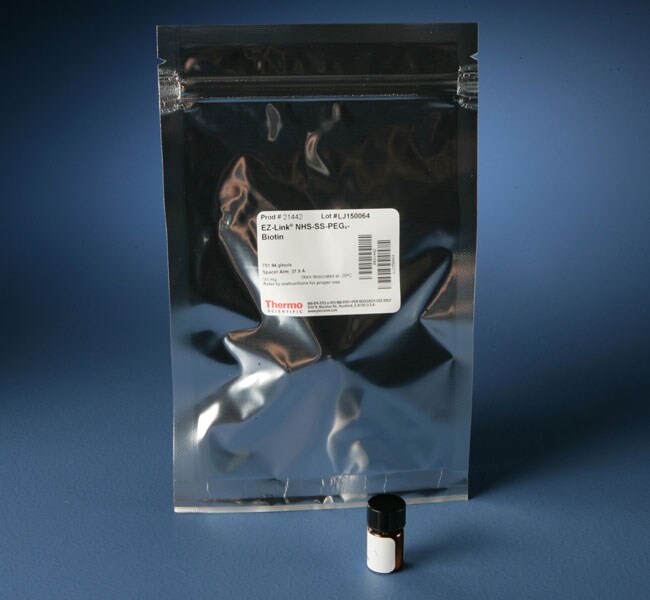
Thermo Scientific EZ-Link NHS-SS-PEG4-Biotin includes disulfide and polyethylene glycol (PEG) groups in its spacer arm to provide biotinylation that is cleavable and which enhances solubility.
Features of EZ-Link NHS-SS-PEG4-Biotin:
• Protein labeling—biotinylate antibodies or other proteins for detection or purification using streptavidin probes or resins
• Amine-reactive—reacts with primary amines (-NH2), such as the side-chain of lysines (K) or the amino-termini of polypeptides
• Cleavable—disulfide bond in spacer arm allows the biotin label to be removed using reducing agents such as DTT; only a small sulfhydryl group remains attached to the molecule
• Pegylated—spacer arm contains a hydrophilic, 4-unit, polyethylene glycol (PEG) group
• Enhances solubility—pegylation imparts water solubility to the biotinylated molecule, helping to prevent aggregation of biotinylated antibodies stored in solution
• Long reach—spacer arm (total length added to target) is 37.9 angstroms; this reduces steric hindrance when binding to avidin molecules
NHS-SS-PEG4-Biotin enables simple and efficient biotin labeling of antibodies, proteins and other primary amine-containing macromolecules. The N-hydroxysuccinimide ester (NHS ester) group reacts specifically and efficiently with protein and peptide lysine (K) and N-terminal amino groups at pH 7-9 to form stable amide bonds. The hydrophilic polyethylene glycol (PEG) spacer arm imparts water solubility that is transferred to the biotinylated molecule, thus reducing aggregation of labeled proteins stored in solution. The integral disulfide bond enables the biotin group to be cleaved from the labeled molecule using DTT or other reducing agents, providing for efficient recovery of avidin-bound protein complexes in affinity-based assays.
We manufacture biotin reagents to ensure the highest possible overall product integrity, consistency and performance for the intended research applications.
N-Hydroxysulfosuccinimide (NHS) esters of biotin are the most popular type of biotinylation reagent. NHS-activated biotins react efficiently with primary amino groups (-NH2) in alkaline buffers to form stable amide bonds. Proteins (e.g., antibodies) typically have several primary amines that are available as targets for labeling, including the side chain of lysine (K) residues and the N-terminus of each polypeptide.
Varieties of biotin NHS-ester reagents differ in length, solubility, cell permeability and cleavability. Non-sulfonated NHS-biotins are cell permeable but must be dissolved in organic solvent such as DMSO or DMF. Sulfo-NHS biotins (and those with pegylated spacers) are directly water soluble but not membrane permeable. Varieties containing disulfide bonds can be cleaved using reducing agents, enabling the biotin group to be disconnected from the labeled protein.
| Code | Description |
|---|---|
| 21442 | Catalog Number: 21442 |

